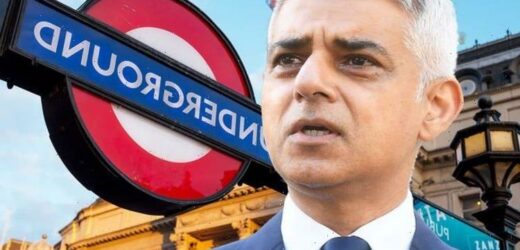Sadiq Khan slammed by voter for 'dropping his Gs'
We use your sign-up to provide content in ways you’ve consented to and to improve our understanding of you. This may include adverts from us and 3rd parties based on our understanding. You can unsubscribe at any time. More info
The capital was flung into chaos last month when nine stations on the London Underground were forced to close due to flooding. Experts warn that, as a result of climate change, extreme weather events are here to stay. The United Nations Environment Programme previously detailed how “floods are made more likely by the more extreme weather patterns caused by long-term global climate change”.
And that poses a huge problem for engineers at Transport For London (TFL).
Asad Rehman, a spokesperson for the COP26 Coalition, told the Financial Times: “Such extreme weather impacts show how vulnerable much of our existing infrastructure is even in cities like London are.”
Dragan Savic, professor of hydroinformatics at the University of Exeter, explained how, as the capital has grown, “we’ve concreted or asphalted over most of the land in the city”.
This means that there is “less capacity to soak up the rain that comes down”.


According to Wired, TFL produced a 2016 report that warned it was “only a matter of time” before the Underground was hit by severe flooding.
It is said to have identified 57 stations at “high risk” of flooding, including King’s Cross, London Bridge, Waterloo, Finsbury Park, Notting Hill Gate, Seven Sisters, Colliers Wood, Stockwell and Marble Arch.
An earlier report, published in 2009 by the Greater London Authority (GLA), reportedly found that 72 London Underground and Docklands Light Railway (DLR) stations are located on floodplains.
And a 2018 version of the same GLA report is said to have found that 20 stations were susceptible to a flood so severe it is expected to happen only once every 100 years.
It noted: “Floodwater getting into underground stations presents a particular hazard and a major engineering problem if the floodwaters were to enter tube tunnels.”

Catherine Russel, a member of the London Assembly, who wrote a 2019 report on the risk of flooding to the UK capital, has sent a warning to Mr Khan.
She said: “Sure enough, when you get a bunch of rain falling on London you get flooded roads, Tube stations and homes, and all the disruption and misery for Londoners they experience from that.”
She worries that Londoners could face a “future of overwhelmed drains, flooded tube stations and streets putting homes and infrastructure at risk if the Mayor fails to accelerate the construction of sustainable drainage systems”.
In 2015, the ‘London Sustainable Drainage Action Plan’ was announced by the former Mayor, Boris Johnson, to “address a specific need to promote the awareness, and the retrofitting, of sustainable drainage systems right across London”.
But it is a long-term strategy and experts have identified more that needs to be done in the meantime.
Prof Savic has handed Mr Khan several other options to ease the flood risk.
DON’T MISS
Black hole shock: Scientist’s dire warning to humans [VIDEO]
Asteroid apocalypse: Scientist warns of ‘city-destroying’ space rock [OPINION]
Why ‘Trillion tonne rock hurtling towards Earth’ was ‘bad news’ [EXPLAINED]

He said: “You have structural options and non-structural options.
“Structurally, you raise the entrances.
“You can even build flood walls and disguise them as a nice set of steps or serpentine entrances where people can go on a bike or a wheelchair.
“There is no way we can eliminate the risk of any flooding.
“As humans, we accept that. We get into our cars and drive into crazy traffic. We accept and manage risk – and we need to do that with flooding.”

Mr Khan says he is doing everything in his power to help as the Environment Agency holds the strategic overview role for all forms of flood risk on behalf of the Department for Environment, Food & Rural Affairs.
Yesterday he called for the government to devolve more funding and powers to local leaders to enable them to better tackle flooding across the capital.
Khan recently met with key partners, including London Councils, Transport for London (TfL), the London Fire Brigade, water companies and the Environment Agency to look at what more can be done to prevent and reduce the impact of flooding in the capital.
He said: “The serious flash flooding in London over the last two weekends will have caused major concern and anxiety for many Londoners and it shows that the dangers of climate change are now moving closer to home.
“Despite having limited powers in the area, it remains a key priority for myself and London’s council leaders that more is done to urgently tackle flooding and the other impacts of climate change.
“This is why I have brought together all of the key partners to see what more can be done, including the water companies who have to address the localised issues with infrastructure that may exacerbate the impact of flooding.”
Source: Read Full Article

